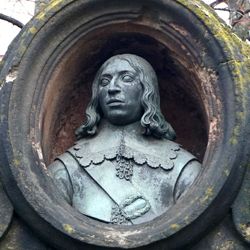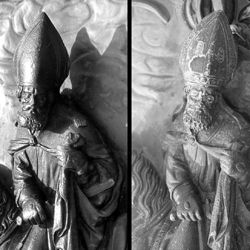Johann (Hans)
Wurzelbauer
brass founder, redsmith
born Nürnberg, 24. Jun 1595
died Nürnberg, 23. Jan 1656
Grave no. 129 in the Johannis cemetery.
Son of Benedikt. ∞ I) 11.9.1621 Maria Magdalena, daughter of the innkeeper and wine grower Michel Bair; II) Dorothea Lochner (* 1624 - † 1682). Pupil of his father. In 1621 he became a master candlestick maker, in 1644 a juror, 1630-56 named. He continued his father's workshop. In 1636, he acquired the former municipal smelting works on Schießgraben (Untere Talgasse 2-4/Auf dem Sand) from the Nuremberg City Council for 1350 fl., where he also lived. In 1618, he is said to have cast four large metal columns and various pictures for King Sigismund of Poland, which together cost 4000 thalers. In 1622, Wurzelbauer received 227½ fl. from the Nuremberg Council for an extension to the Fugger grille in the large town hall. At times, he had to struggle with economic difficulties as a result of the Thirty Years' War (1618-48). In 1636, Wurzelbauer traveled to Regensburg, where Emperor Ferdinand II commissioned him with a "special work", which was not carried out due to the emperor's early death. According to Doppelmayr, he delivered a large chandelier worth 6000 thalers to Moscow in 1653. Much of the work he delivered for high-ranking foreign clients has been lost. His widow married Johann Philipp Kob, a brass merchant.
works: NUREMBERG, Sebalduskirche: Crucifix, 1625; -, Johannisfriedhof: Epitaph of the Schuhknechte on grave A 1b; -, Tomb for General Claus Hastver, 1634, formerly in the Dominikanerkirchrave no. 129 in the Johannis cemetery.
Son of Benedikt. ∞ I) 11.9.1621 Maria Magdalena, daughter of the innkeeper and wine grower Michel Bair; II) Dorothea Lochner (* 1624 - † 1682). Pupil of his father. In 1621 he became a master candlestick maker, in 1644 a juror, 1630-56 named. He continued his father's workshop. In 1636, he acquired the former municipal smelting works on Schießgraben (Untere Talgasse 2-4/Auf dem Sand) from the Nuremberg City Council for 1350 fl., where he also lived. In 1618, he is said to have cast four large metal columns and various pictures for King Sigismund of Poland, which together cost 4000 thalers. In 1622, Wurzelbauer received 227½ fl. from the Nuremberg Council for an extension to the Fugger grille in the large town hall. At times, he had to struggle with economic difficulties as a result of the Thirty Years' War (1618-48). In 1636, Wurzelbauer traveled to Regensburg, where Emperor Ferdinand II commissioned him with a "special work", which was not carried out due to the emperor's early death. According to Doppelmayr, he delivered a large chandelier worth 6000 thalers to Moscow in 1653. Much of the work he delivered for high-ranking foreign clients has been lost. His widow married Johann Philipp Kob, a brass merchant.
Works: NUREMBERG, Sebalduskirche: Crucifix, 1625; -, Johannisfriedhof: Epitaph of the Schuhknechte on grave A 1b; -, Tomb for General Claus Hastver, 1634, formerly in the Dominikanerkirche (not preserved, model by Hans von der Pütt in the GNM).
MuS: NÜRNBERG, GNM. WÜRZBURG, Mainfränk. Mus.: choir desk, 1644 (formerly Dom).
Lit.: Thieme-Becker; Doppelmayr, 1730; Trechsel, 1735; Roth, 1802; Lockner Nr. 662; Barock, 1962, S. 116; Maué, 1997, S. 72-74; Kohn, NHb Sebald.
(quoted from the Nurnberger Künstlerlexikon, edited by Manfred H. Grieb)
Style: Baroque
Period: 17th c.





